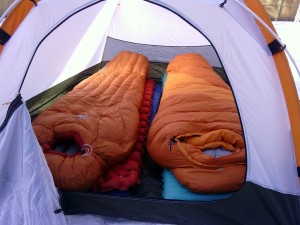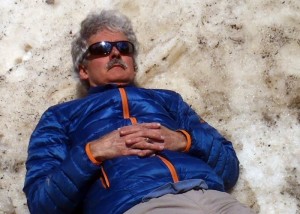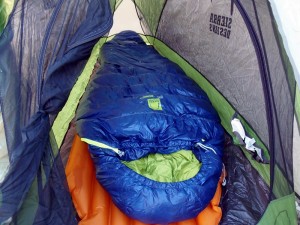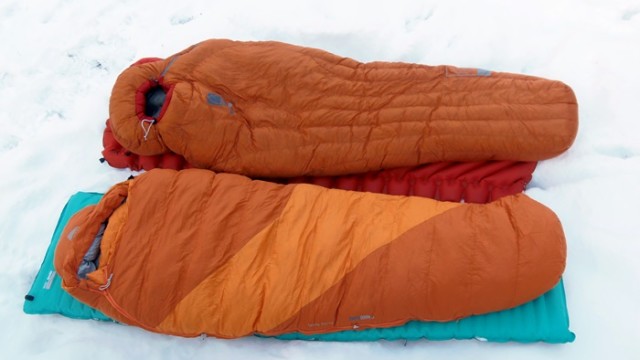(Editor’s note: There are a number of hydrophobic down formulations (Dry Down) on the market at this point, and while it’s likely that they have relatively similar characteristics, we have, so far, only specifically tested DriDown™. So, our observations only relate to products using this specific version of “new dry down.” We’re hoping to test other versions in the future and would be happy to hear from readers who have tried other types!)
Down has always been the best of insulation and the worst of insulation. Even after the best part of a half century of constant research into better and better synthetics, down’s insulation/weight/compressibility ratio is still unparalleled. Beyond that, there’s a feeling to down that is hard to quantify; it’s often described as “coziness,” or “airiness.” In our opinion, it comes from body moisture moving through the material more quickly than with synthetics, creating a less humid environment next to your skin and allowing your “wicking layer” to do its job. The best synthetics approach that now, but there’s still “a certain something” to down.

But, the other side of that coin is that if down gets wet, it clumps and loses its insulating value. That makes it unsuitable for many uses, and also means that many potential users avoid it because they’re simply afraid that when they need it, it won’t work. Call it the “Toyota effect;” we know many people who don’t like their cars that well, but bought them because they felt they’d be more reliable than what they really wanted.
The dream has always been an insulation that insulates like down, but maintains at least some insulating value when wet. Primaloft, Climashield, Polarguard, and a host of other companies have tried, and…well…they’ve gotten close, but they still haven’t quite matched that down feel. Recent advances in chemistry and high-tech particles have created a different paradigm; why not try to get down to work like synthetic? Now, there’s a concept…Dry Down…and that’s DriDown™. By putting a hydrophobic (water repelling) finish on the individual fibers of the down clusters, the Dry down insulation simply doesn’t get as wet. Great idea, if it works!
We were totally intrigued by the concept; we’ve been fighting back and forth amongst ourselves for decades about the best insulation for different conditions, and wondered whether this might be the “one size fits all” that we’ve always dreamed about. American Rec, the parent company for, among others, Sierra Designs & Kelty, was good enough to agree to let us try several items with DriDown™. After much thought, we decided on a “puffy” jacket as an apparel piece; because of its use as both a mid layer and an outer layer, we’d get more “feel” for what the down is doing than with any other jacket. We chose the Gnar Light, as we’d had direct experience with the Gnar Hoody earlier, so it was a great comparison (unfortunately, no DriDown hooded version was available at the time of testing). Sleeping bags…we went back and forth on this one. We agreed that winter bags are the worst case scenario; low temperatures and tight tents = ridiculously high humidity levels, and cold weather during the day = no ability to dry the bags. We also wanted to try different fill powers, to make sure we weren’t getting fooled by a particularly spectacular bit of down. So, we narrowed it down to the Kelty Ignite 0, which is a 600 fill power bag; the Sierra Designs Zissou 6, at 700 FP; and while the Sierra Designs Cal 6, which would have been the exact comparison, wasn’t available at the time, they sent the Cal 13, an utterly gorgeous bag with 800 FP down and InsoTect Flow baffles.

And out they went into the field…over and over and over. At the start, the piece that got the most use and abuse was the Gnar Light; we could pass it around and use it daily. Everybody loved it, as they had the original one, but it took one editor to notice something odd; he would come in from the cold and go shopping, etc., and almost never felt hot in the jacket…at worst, he’d have to unzip, but virtually never took it off. That’s unusual for this particular character, who’s often seen in a t-shirt and khakis in February. Hmmm…a data point.
Then, the sleeping bags started going out…and in came the feedback. The first thing we heard was that ALL of them easily outperformed their ratings; one testing pair had the Zissou and Ignite in a tent on a windy -9F night, and, quote, “we didn’t even fully zip up until well after midnight.” That’s quite a compliment to the designers; almost never do ALL testers find the bags outperforming spec. Even women were comfy at ridiculously low temperatures, particularly in the Kelty, which has a spectacularly well designed hood that makes it easy to keep heat in and cold out. The fill power didn’t make a difference in how the bags performed vis-a-vis temperature rating, but testers were pretty evenly divided on their favorite; some loved the coziness created by higher density 600FP down, while some were blown away by the lightness and airiness of the 800.
But the piece of feedback that was most fascinating was from the testers in the small tent; when they got up in the morning, their bags were SOAKED. All along the seams on the outside of the bags, they were wet or icy. Hmmm…another data point, and a confusing one.
And then the light bulb went on. On a night when we’d gone out with the Zissou and another non-DriDown bag, we had the same thing happen; the Zissou was wet, the other bag wasn’t, and yet the sleeper in the Zissou had slept wonderfully. When we got the bags home, we weighed them…and then dried them, and weighed them again. Both of them lost weight, but the Zissou lost about 4 ounces; the other bag, 6. In other words, the other bag, while appearing to be dry, had retained MORE water weight. The DriDown bag, on the other hand, had either had less moisture from the sleeper in it to begin with…or, based on being able to flick some ice off the outside, we think that it simply transported MORE moisture from the warm side to the cold.
That brought us back to the jacket, and its exceptional temperature range. If the DriDown was moving moisture from the source (the body) to the surface of the jacket more efficiently than regular down, that would mean a less humid environment inside the jacket. The more humid the air, the more efficiently it transports heat, in BOTH directions. So, more moisture in the down would mean that the jacket would feel colder when outdoors, and hotter indoors. Beyond that, more moisture in non-hydrophobic down would subtly decrease loft, further compromising the insulating value, increasing how obvious the effect feels; with a really dry jacket, you’re comfortable outside when it’s cold, and comfortable inside when it’s hot. Make it damp, and you’re shivering outside and clammy inside.

With that insight, we looked at our reactions to the sleeping bags…and had another “aha!” moment. All of the bags we had been using, DriDown or regular down had been EN tested. Now, we have issues with the EN13537 spec; fit and drape can be as important or even MORE important than sheer insulating value. But, we’ve had good bags that fit us well, sometimes even better than the DriDown bags, and still all had the same reaction; these bags are WARM and COMFORTABLE. There’s no way that the EN testing can take into account the effect of perspiration, so all bags would react the same. But in the real world, if a bag, like the jacket, creates a more humid atmosphere (clammy), it’s going to be colder; that’s just basic physics. And, if we’re correct, it means that a DriDown bag will be warmer in real-world use than a regular down bag, even when there’s no obvious moisture issues.
And, of course, it’ll also be more comfortable when the temperature is higher; think about a 70 degree summer night when the humidity is low, and how comfortable sleep is versus on one of those muggy, sticky nights, and you’ll get the picture. We’d actually love to see a DriDown 40 degree bag; that’s another worst case scenario, as we’ve often had nights where it jumped into the 60s, and we were clammy in our bags, but it wasn’t quite warm enough to sleep on top. Would a DriDown bag allow us to stay inside comfortably?
At this point, this is still theory and based on our own experience; there’s been no independent scientific testing to confirm or deny it that we’re aware of. And, other factors can come into play; shell fabrics and how they treat moisture, for instance. We can’t speak to the longevity of the treatment, or whether it will cause the down clusters to break apart faster than plain down; in 20 years, we may know the answer to that. But at this point, we’re confident enough to say that we’re comfortable embracing DriDown™, taking it into the backcountry where lousy insulation can create situations that range from miserable to dangerous, with no reservations. Our money, literally and figuratively, is on hydrophobic down; at the very least, we’re confident that it’s a significant improvement over the natural thing, and it may outperform synthetics at their own game. More testing to come, but for now the answer to our title is…yes, it IS a game changer!



do you have any updates on the longevity of this material?? Many sleeping bags are still using it and I’m not quite sold on it’s charateristics.
Longevity is something that we won’t really be able to assess for a couple of decades, unfortunately. That said…at this point, we’ve had zero complaints about how DriDown has continued to perform. This may sound silly, but we’ve actually kept the Kelty Ignite DriDown in a stuff sack between uses (obviously, after drying it out!) to see if we’d notice any change in loft. That means roughly 10 months at a time compressed, something that isn’t recommended with any down. And…no issues, period. So, it’s a tradeoff; a chance that it won’t work for as long vs. better function now. We’re coming down pretty strongly on the “enjoy it while it lasts” side, based on our experiences so far…we’re using down in situations we never would have before, and are thrilled with the performance. Will we only get 10 years out of the bag instead of 20? Our feeling is that if that happens, to abuse Shakespeare, “Tis better to have loved and lost…”